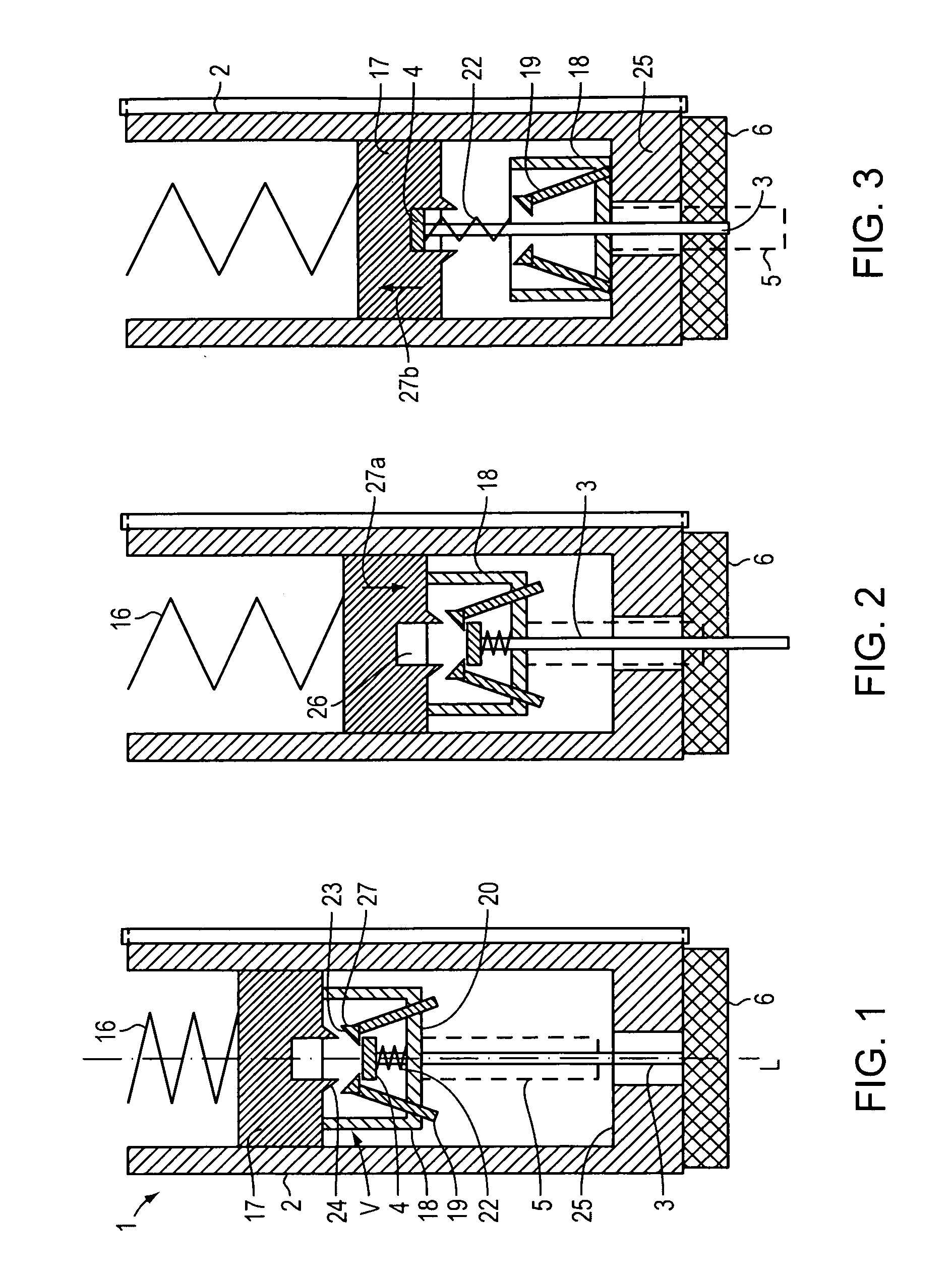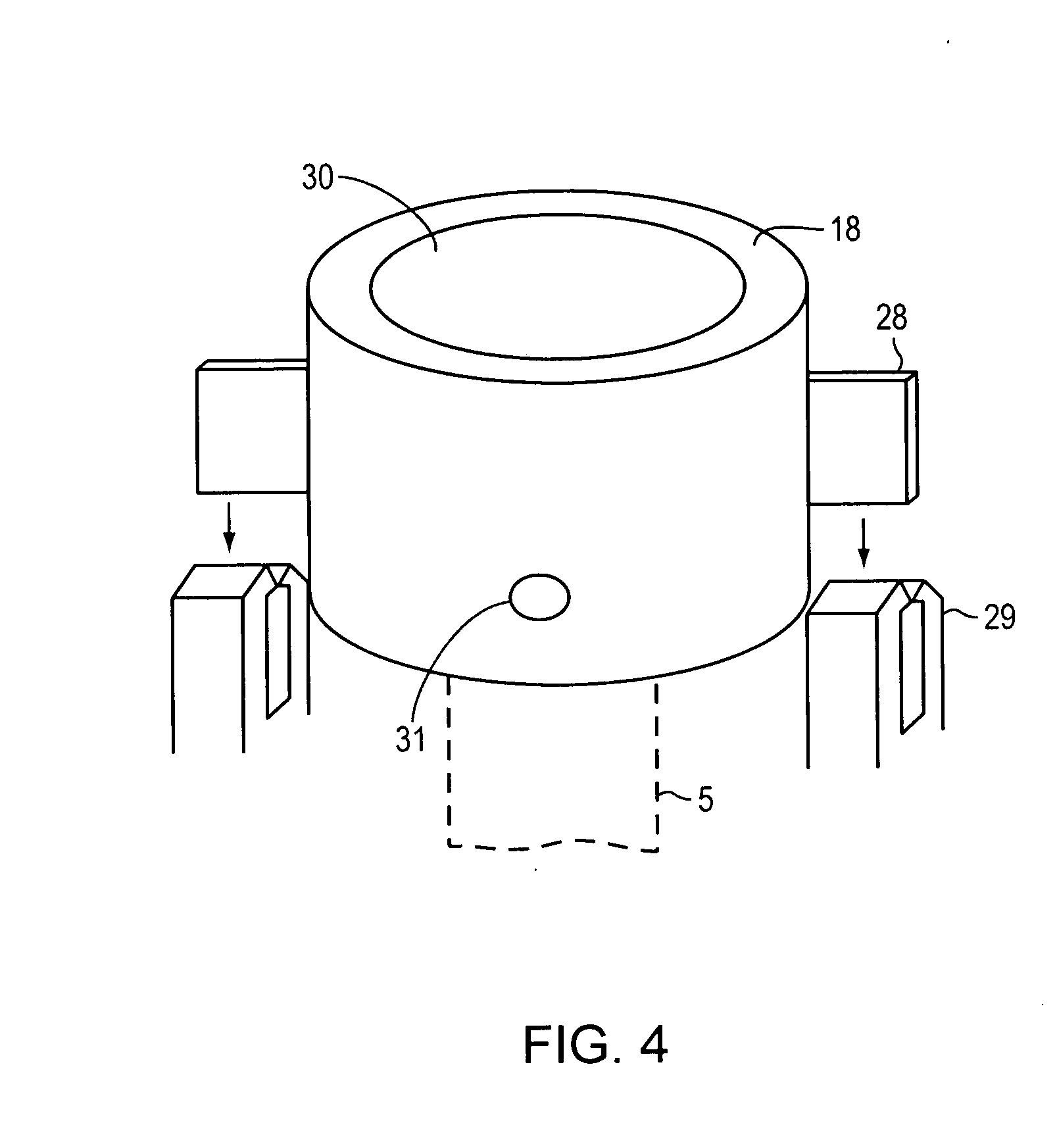[0007]During an
insertion procedure described herein, a cannula is used in conjunction with a needle. The needle is used to penetrate the body. Subsequently, the needle is withdrawn from the body, allowing the cannula to remain in its inserted position. Consequently, one
advantage of the invention is to increase the comfort of a patient during the insertion and withdrawal of a
catheter or cannula. This benefit may be achieved with a device for the insertion of a cannula of the type described herein, wherein the needle, after reaching its extended state, can be withdrawn quickly and automatically by a retraction apparatus.
[0008]One embodiment of the invention allows the needle to not only quickly penetrate the
body tissue (i.e.,
blood vessel, organ, or other body part) of a patient, but due to aid from the retraction apparatus, the needle is quickly withdrawn from the
body tissue and simultaneously, the inserted cannula remains within the
body tissue. In this way, since the needle is relatively quickly withdrawn from the body tissue, a much more comfortable
sensation is experienced than that associated with a slower insertion and withdrawal. Further, any
sensation is transient. The retraction apparatus is activated, in any case, when the needle is already within the patient's tissue, that is to say, when the needle is in its extended position. Thereby, it is possible for the operator to insert the needle and its associated cannula to a sufficient depth to reach a desired position within the body tissue.
[0009]In one embodiment, the driving element or needle
plunger is subject to the force of a spring. The spring can be prestressed and restrained by an arresting apparatus from which it is released to carry out its driving function. The spring acts upon a drive mechanism, which includes at least one first part (e.g., a
plunger), which is in driving contact with a free end of the spring and the drive mechanism includes one separate second part (e.g., a support structure), indirectly activated by the spring. Thus, the second part is made slidingly displaceable in a first direction by means of the motion of the first part and, conversely, separates itself therefrom upon a movement of the first part in an opposite direction. Such an arrangement reduces the weight, which contributes to
momentum during the retraction of the needle. Simultaneously, the needle, upon its movement from the retracted position into the extended position, stabilizes the cannula sufficiently when so projected, so that that the
insertion procedure can be reliably carried out.
[0010]In certain embodiments, the needle, which is seated in the second part, is releasably held. Accordingly, the needle can disengage itself from the second part at the outset of a retracting motion and can be withdrawn without obstruction. In this way, the needle is not permanently affixed to the drive mechanism, an
advantage which can be usefully employed to even move the needle more quickly, i.e., through more rapid increments of retractive motion.
[0011]At the time that the needle is disconnected from the second part, nothing more than the weight of the needle need be placed in motion, an
advantage which allows undiminished acceleration. Since the movement of a needle within the body tissue can be uncomfortable, it is helpful if the displacement of the needle can be accelerated so that it can be removed from the tissue in a minimal amount of time.
[0012]In one embodiment, the activation of the needle is subjected to force by a separate retraction spring (compression type) dedicated thereto, which acts in a direction from the second part toward the first part. It is possible, then, that this retraction spring serving the needle can be employed to force the now-released needle away from the second part in a direction that withdraws it from the penetrated body tissue. The second part can include at least one holding element that retains the needle therein, and permits the needle to be subsequently retracted from an extended position. The concept of “retraction” or “withdrawal,” as used herein, is used to describe removal of the needle from the lumen of the cannula after full insertion or extension of the cannula. The method of construction of the holding element, that is, as to whether its retaining characteristic is due to mechanical, magnetic, or other induced forces, is of secondary importance for the purpose of this description. During the interim within which the needle has not yet reached its extended position, the holding element acts to
affix the needle within the second part. As soon as the second part has reached its final and extended position, the retention of the needle is no longer necessary. Accordingly, at this time, the holding element releases the needle, so that it departs from the second part and extricates itself therefrom.
 Login to View More
Login to View More  Login to View More
Login to View More 


